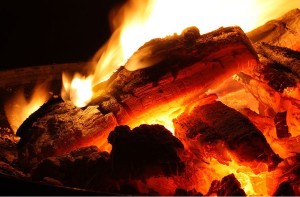The consequences of Forest fires

Techniques are increasing and more and better material and personnel are being used to master forest fires, but the situation itself has not really changed very much throughout the ages. Forest fires have existed here since eternal times. The vegetation suffers, but is never completely destroyed; it regenerates again in about two years. The native flora has become accustomed to the fires and reacts appropriately. Pine trees and aromatic plants such as thyme and rosemary, and heather and brooms thrive here naturally. All these plants have strong roots and few leaves and two additional common characteristics: They regenerate fast and are, unfortunately, also very flammable. It would be much better to plant other trees, for example cork oaks, olives or almond trees, as were common when there was more agriculture in our area. The leaves of these trees are juicier and do not burn as easily. More fire-resistant trees would not prevent all forest fires but would reduce their number and the area burned. These trees also cost more than pine trees, and grow slowly. Thus the government must decide if they wish to invest funds now for the future, or spend less, now, and wait and spend money on fire- fighting and restoration.
The danger continues after the fire: the ground, without plants to stabilize it is susceptible to being washed away by rainwater, especially on steeply sloped areas. Fortunately, the remained underground roots help to keep the soil stable, even after a big fire; even dead roots are still able to retain some of the earth. But, the best protection against soil erosion is thick healthy vegetation. In a certain sense, however, just only in this sense, forest fires are useful for the quality of the earth. After a fire the introduction of burned wood adds numerous mineral materials to the soil.
A fire also dramatically impacts the lives of animals. Insects are the first to lose their lives to heat and smoke. Also eggs, which were laid in trees, etc. are destroyed. Birds can save themselves and most other animals have a threat warning system and are usually able to migrate away from the danger to a safe area. They search for another living space and may decide to return to the danger area when there are appropriate conditions for their well-being. That may take many years. Pines need about 5 years to reach a size that can provide protection for the creatures. A fire can, however, be so rapid and spread over such s big areas that animals are encircled and die.
Trees sweat as people and introduce moisture to the air when it is hot. If the trees are missing after a fire, the climate becomes drier and this, in turn is conducive for other fires. The forest fires of our area are, however, usually localized events. If two mountain ridges burn, this does not change the climate of an area. So the forest fires have hardly perceptible influence onto the climate of our area.


Sad but it is a reality now. There are no single solutions for problems, but using combinations of fire resistant plants, and other solutions such as using Military assets with fire fighting systems (like the MAFFS products for a C130), could really bolster Spain’s ability to mitigate the problems.